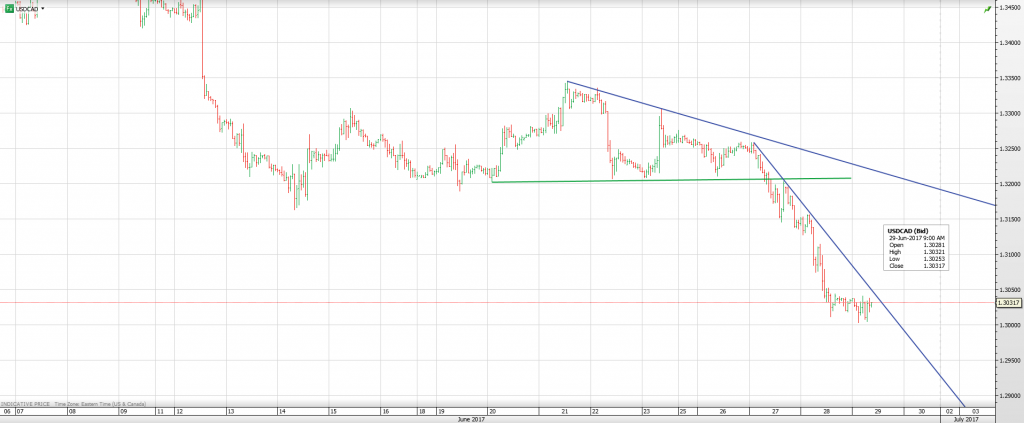USDCAD retested the overnight low (and major support) on a post GDP dip to 1.2957 but the data was strong enough to extend losses. Canada GDP grew 0.2% in April, down from March’s 0.5% gain. The decline was expected. Industrial Product Prices and Raw Material Price index were below expectations.
At the same time US Personal Income data was released. Income grew at 0.4%, a tic higher than expected while PCE came in as forecast. The US dollar shrugged off the news. Chicago PMI and Michigan Consumer Confidence are still to come.
FX traders have their eye on the month end fix at 11:00 (8:00 am PDT). Once those flows are out of the way, traders will be heading for the exits to get an early start to the Canada Day long weekend and in the US and extended July 4 holiday.
EURUSD did not go anywhere in Asia but sank in Europe, falling from 1.1444 to 1.1393 which is where is was at the start of today’s session. It has since ticked up to 1.1418. EURUSD is under mild downward pressure due to concerns that a thin market will lead to an “overdue” correction. Selling was encouraged by a dip in June headline Eurozone CPI to 1.3% from 1.4% in May. However, core CPI beat the estimates and rose to 1.2% from 1.0%.
GBPUSD traded higher in Asia, rising from 1.2995 to 1.3028. A mix of profit taking and a modest bounce in the broad US dollar led to a drop to 1.2961 in New York trading.
The Asia session kicked off with a host of economic data reports from Japan, including CPI, Employment, and Industrial Production. May Inflation was unchanged at 0.4%, y/y, the unemployment rated ticked up to 3.1% from 2.8% and Industrial Production was -3.3%. USDJPY eased from 112.14 to 111.95, then fully retraced the move. It is currently sitting at 112.18
China Official Manufacturing PMI for June was 51.7 vs forecast of 51.0. AUDUSD and NZDUSD rallied on the news, but only Kiwi held on to them. AUDUSD rose from 0.7677 to 0.7709 and then drifted lower, making a low of 0.7670 in Europe. It has not moved far from the overnight low in today’s session. NZDSD rose from 0.7294 to 0.7333, but has since ticked lower.
Oil prices moved higher rising to a peak of $45.39. This week’s price gains have a lot to do with US dollar weakness and quarter-end position adjustments rather than a rebalancing of supply and demand.
The Bank of Canada’s Business Outlook Survey is also due. It is expected to paint an upbeat outlook on the economy.
Month end and quarter end portfolio rebalancing flow s may not be much of a factor as a couple of forecasts suggest only small US dollar selling.
USDCAD Technical outlook:
The intraday and short term USDCAD technicals are bearish. They are looking for a break of support in the 1.2965 area to extend losses to 1.2770. Arguably, a 0.0500 point drop in two weeks on mere “TALK” of a rate hike is a tad excessive, especially since there isn’t any chatter of additional hikes to follow. USDCAD selling pressure may have been worsened by month end flows. However, support in the 1.2965 area has contained downside moves since September 2016. For today, USDCAD support is at 1.2965 and 1.2940. Resistance is at 1.3010 and 1.3050.
Today’s Range 1.2950-1.3010
Chart: USDCAD 4 hour






